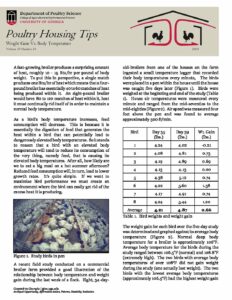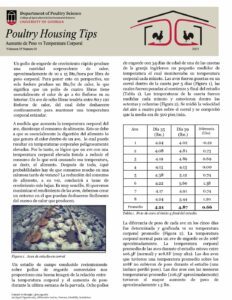A fast-growing broiler produces a surprising amount of heat, roughly 10 - 15 Btu/hr per pound of body weight. To put this in perspective, a single match produces one Btu/hr of heat which means that a four-pound broiler has essentially 40 to 60 matches of heat being produced within it. An eight-pound broiler would have 80 to 120 matches of heat within it, heat it must continually rid itself of in order to maintain a normal body temperature.
As a bird’s body temperature increases, feed ...consumption will decrease. This is because it is essentially the digestion of feed that generates the heat within a bird that can potentially lead to dangerously elevated body temperatures. So it stands to reason that a bird with an elevated body temperature will tend to reduce its consumption of the very thing, namely feed, that is causing its elevated body temperatures. After all, how likely are we to eat a big meal on a hot summer afternoon? Reduced feed consumption will, in turn, lead to lower growth rates. It’s quite simple. If we want to maximize bird performance we must create an environment where the bird can easily get rid of the excess heat it is producing.
A recent field study conducted on a commercial broiler farm provided a good illustration of the relationship between body temperature and weight gain during the last week of a flock. Eight, 34-day-old-broilers from one of the houses on the farm ingested a small temperature logger that recorded their body temperatures every minute, The birds were placed in a pen within the house until the house was caught five days later (Figure 1). Birds were weighed at the beginning and end of the study (Table 1). House air temperatures were measured every minute and ranged from the mid-seventies to the mid-eighties (Figure 2). Air speed was measured four feet above the pen and was found to average approximately 500 ft/min.
The weight gain for each bird over the five-day study was determined and graphed against its average body temperature (Figure 2). Normal deep body temperature for a broiler is approximately 106oF. Average body temperature for the birds during the study ranged between 106.5oF (normal) and 108.8oF (extremely high). The two birds with average body temperatures of over 108oF did not gain weight during the study (one actually lost weight). The two birds with the lowest average body temperatures (approximately 106.5oF) had the highest weight gain of approximately 1.3 lbs. There was no correlation between initial body weight and body temperature. This is likely due to the fact that there was a minimal difference in the initial weights among the birds.
As documented in this, as well as previous field studies, there is a significant variation in bird body temperatures within a house (Figure 3). The variation can be due to differences in location within a house, density in the vicinity of a given bird, bird size, genetics, growth rate, health status, etc. For instance, the bird with the highest body temperature was found to have a slight respiratory infection. The other bird with an average body temperature of over 108oF likely had some other health issue but a necropsy of the bird did not find any obvious health issues. The fact remains whether an elevated body temperature is due to illness or insufficient heat removal due to high ambient temperature/RH, a bird’s response will be the same; it will consume less feed, and as a result gain less weight.
The objective of managing the environment during hot weather is quite simple, to make sure we remove enough heat from the birds through the use of air speed and evaporative cooling that birds don’t have to reduce their consumption of feed to limit their heat production. If a bird has to try to lower its body temperature, performance will suffer. They will pant, which will tend to make feed conversion rates worse and/or back off of feed, which will lower their growth rates. The greater the amount of heat we pull from the birds, the more likely they will have a stable body temperature and continue to eat the feed required to maximize weight gain and overall performance.
Do we have to be concerned about potentially over cooling market-age birds during summertime? In most cases, no. A market-age bird has much greater ability to limit its heat loss than to increase its heat loss. For instance, a bird can dramatically lower its heat loss by simply fluffing its feathers. The trapped air between the feathers increases their insulation value, which lowers bird heat loss even with high levels of air moving across the bodies. Birds can sit closer together or pull their wings closer to their bodies, further lowering their potential heat loss. When compared to a bird’s primary method of ridding itself of excess heat, panting, these heat conservation efforts require very little effort from the birds. As a result, it is far safer with market-age birds to maximize air movement over them 24/7 than, for instance, turning a few fans off at night for fear of “chilling” the birds.
Though this field study was limited in scope, and further trials need to be conducted, it does reinforce a basic hot weather bird management principle: The more a heat a producer can remove from their birds, the better they will perform. The best way for producers to remove excess heat from their birds during hot weather is through wind speed. The greater the wind speed in a house, the greater the heat removed from the birds, the lower the birds’ body temperatures will be, the more feed they will eat, and the more weight they will gain.
ATTACHMENTS
Details
| Year | Volume | Number | Categories |
|---|---|---|---|
| 2023 | 35 | 10 |


